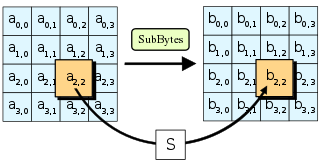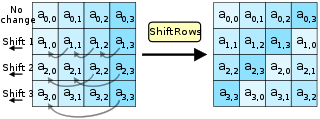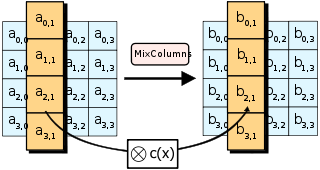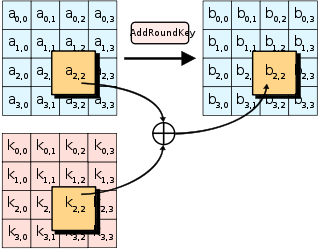
The SubBytes step, one of four stages in a
round of AES |
| General |
| Designers |
Vincent Rijmen,
Joan Daemen |
| First published |
1998 |
| Derived from |
Square |
| Successors |
Anubis,
Grand Cru |
| Certification |
AES winner,
CRYPTREC,
NESSIE,
NSA |
| Cipher detail |
|
Key sizes |
128, 192 or 256 bits[1] |
|
Block sizes |
128 bits[2] |
| Structure |
Substitution-permutation network |
| Rounds |
10, 12 or 14 (depending on key size) |
| Best public
cryptanalysis |
|
All known attacks are computationally infeasible. For AES-128,
the key can be recovered with a computational complexity of 2126.1
using
bicliques. For biclique attacks on AES-192 and AES-256, the
computational complexities of 2189.7 and 2254.4
respectively apply.
Related-key attacks can break AES-192 and AES-256 with
complexities 2176 and 299.5, respectively. |
The Advanced Encryption Standard (AES) is a
specification for the
encryption of electronic data established by the U.S.
National Institute of Standards and Technology (NIST) in 2001.[3]
Originally called Rijndael, the
cipher
was developed by two
Belgian
cryptographers,
Joan Daemen and
Vincent Rijmen, who submitted to the AES selection process.[4]
AES has been adopted by the
U.S. government and is now used worldwide. It supersedes the
Data Encryption Standard (DES),[5]
which was published in 1977. The algorithm described by AES is a
symmetric-key algorithm, meaning the same key is used for both
encrypting and decrypting the data.
In the
United States, AES was announced by the NIST as U.S.
FIPS PUB 197 (FIPS 197) on November 26, 2001.[3]
This announcement followed a five-year standardization process in which
fifteen competing designs were presented and evaluated, before the
Rijndael cipher was selected as the most suitable (see
Advanced Encryption Standard process for more details). It became
effective as a federal government standard on May 26, 2002 after
approval by the
Secretary of Commerce. AES is included in the ISO/IEC 18033-3
standard. AES is available in many different encryption packages, and is
the first publicly accessible and open
cipher
approved by the
National Security Agency (NSA) for
top secret information when used in an NSA approved cryptographic
module (see
Security of AES, below).
The name Rijndael (Dutch pronunciation: [ˈrɛindaːl])
is a play on the names of the two inventors. Strictly speaking, the AES
standard is a variant of Rijndael where the block size is restricted to
128 bits.
Description
of the cipher
AES is based on a design principle known as a
substitution-permutation network, and is fast in both software and
hardware.[6]
Unlike its predecessor DES, AES does not use a
Feistel network. AES is a variant of Rijndael which has a fixed
block size of 128
bits, and a
key
size of 128, 192, or 256 bits. By contrast, the Rijndael
specification per se is specified with block and key sizes that
may be any multiple of 32 bits, both with a minimum of 128 and a maximum
of 256 bits.
AES operates on a 4×4
column-major order matrix of bytes, termed the state,
although some versions of Rijndael have a larger block size and have
additional columns in the state. Most AES calculations are done in a
special
finite field.
The key size used for an AES cipher specifies the number of
repetitions of transformation rounds that convert the input, called the
plaintext, into the final output, called the ciphertext. The number of
cycles of repetition are as follows:
- 10 cycles of repetition for 128-bit keys.
- 12 cycles of repetition for 192-bit keys.
- 14 cycles of repetition for 256-bit keys.
Each round consists of several processing steps, including one that
depends on the encryption key itself. A set of reverse rounds are
applied to transform ciphertext back into the original plaintext using
the same encryption key.
High-level description of the algorithm
- KeyExpansion—round keys are derived from the cipher key using
Rijndael's key schedule
- Initial Round
- AddRoundKey—each byte of the state is combined with
the round key using bitwise xor
- Rounds
- SubBytes—a non-linear substitution step where each
byte is replaced with another according to a
lookup table.
- ShiftRows—a transposition step where each row of
the state is shifted cyclically a certain number of steps.
- MixColumns—a mixing operation which operates on the
columns of the state, combining the four bytes in each column.
- AddRoundKey
- Final Round (no MixColumns)
- SubBytes
- ShiftRows
- AddRoundKey
The SubBytes
step

In the
SubBytes step, each byte in the state is
replaced with its entry in a fixed 8-bit lookup table,
S;
bij =
S(aij).
In the SubBytes step, each byte in the state matrix
is replaced with a SubByte using an 8-bit
substitution box, the
Rijndael S-box. This operation provides the non-linearity in the
cipher.
The S-box used is derived from the
multiplicative inverse over
GF(28), known to have good non-linearity
properties. To avoid attacks based on simple algebraic properties, the
S-box is constructed by combining the inverse function with an
invertible
affine transformation. The S-box is also chosen to avoid any fixed
points (and so is a
derangement), and also any opposite fixed points.
The ShiftRows
step

In the
ShiftRows step, bytes in each row of the
state are shifted cyclically to the left. The number of
places each byte is shifted differs for each row.
The ShiftRows step operates on the rows of the state; it
cyclically shifts the bytes in each row by a certain
offset. For AES, the first row is left unchanged. Each byte of the
second row is shifted one to the left. Similarly, the third and fourth
rows are shifted by offsets of two and three respectively. For blocks of
sizes 128 bits and 192 bits, the shifting pattern is the same. Row n is
shifted left circular by n-1 bytes. In this way, each column of the
output state of the ShiftRows step is composed of bytes from
each column of the input state. (Rijndael variants with a larger block
size have slightly different offsets). For a 256-bit block, the first
row is unchanged and the shifting for the second, third and fourth row
is 1 byte, 3 bytes and 4 bytes respectively—this change only applies for
the Rijndael cipher when used with a 256-bit block, as AES does not use
256-bit blocks.
The
MixColumns step

In the
MixColumns step, each column of the state is
multiplied with a fixed polynomial
c(x).
In the MixColumns step, the four bytes of each column of the
state are combined using an invertible
linear transformation. The MixColumns function takes four
bytes as input and outputs four bytes, where each input byte affects all
four output bytes. Together with ShiftRows, MixColumns
provides
diffusion in the cipher.
During this operation, each column is multiplied by the known matrix
that for the 128-bit key is
-
-

The multiplication operation is defined as: multiplication by 1 means
no change, multiplication by 2 means shifting to the left, and
multiplication by 3 means shifting to the left and then performing
xor with the initial unshifted value. After shifting, a conditional
xor with 0x11B should be performed if the shifted value is larger
than 0xFF.
In more general sense, each column is treated as a polynomial over
GF(28) and is then multiplied modulo x4+1
with a fixed polynomial c(x) = 0x03 · x3 + x2 + x
+ 0x02. The coefficients are displayed in their
hexadecimal equivalent of the binary representation of bit
polynomials from GF(2)[x]. The MixColumns step can also
be viewed as a multiplication by a particular
MDS
matrix in a
finite field. This process is described further in the article
Rijndael mix columns.
The
AddRoundKey step

In the
AddRoundKey step, each byte of the state is
combined with a byte of the round subkey using the
XOR operation (⊕).
In the AddRoundKey step, the subkey is combined with the
state. For each round, a subkey is derived from the main
key using
Rijndael's key schedule; each subkey is the same size as the state.
The subkey is added by combining each byte of the state with the
corresponding byte of the subkey using bitwise
XOR.
Optimization of the cipher
On systems with 32-bit or larger words, it is possible to speed up
execution of this cipher by combining the SubBytes and
ShiftRows steps with the MixColumns step by transforming
them into a sequence of table lookups. This requires four 256-entry
32-bit tables, and utilizes a total of four kilobytes (4096 bytes) of
memory — one kilobyte for each table. A round can then be done with 16
table lookups and 12 32-bit exclusive-or operations, followed by four
32-bit exclusive-or operations in the AddRoundKey step.[7]
If the resulting four kilobyte table size is too large for a given
target platform, the table lookup operation can be performed with a
single 256-entry 32-bit (i.e. 1 kilobyte) table by the use of circular
rotates.
Using a byte-oriented approach, it is possible to combine the
SubBytes, ShiftRows, and MixColumns steps into a
single round operation.[8]
Security
Until May 2009, the only successful published attacks against the
full AES were
side-channel attacks on some specific implementations. The
National Security Agency (NSA) reviewed all the AES finalists,
including Rijndael, and stated that all of them were secure enough for
U.S. Government non-classified data. In June 2003, the U.S. Government
announced that AES could be used to protect
classified information:
The design and strength of all key lengths of the AES algorithm
(i.e., 128, 192 and 256) are sufficient to protect classified
information up to the SECRET level. TOP SECRET information will
require use of either the 192 or 256 key lengths. The implementation
of AES in products intended to protect national security systems
and/or information must be reviewed and certified by NSA prior to
their acquisition and use."[9]
AES has 10 rounds for 128-bit keys, 12 rounds for 192-bit keys, and
14 rounds for 256-bit keys. By 2006, the best known attacks were on 7
rounds for 128-bit keys, 8 rounds for 192-bit keys, and 9 rounds for
256-bit keys.[10]
Known attacks
For cryptographers, a
cryptographic "break" is anything faster than a
brute force—performing one trial decryption for each key (see
Cryptanalysis). This includes results that are infeasible with
current technology. The largest successful publicly known
brute force attack against any block-cipher encryption was against a
64-bit RC5
key by
distributed.net in 2006.[11]
AES has a fairly simple algebraic description.[12]
In 2002, a theoretical attack, termed the "XSL
attack", was announced by
Nicolas Courtois and
Josef Pieprzyk, purporting to show a weakness in the AES algorithm
due to its simple description.[13]
Since then, other papers have shown that the attack as originally
presented is unworkable; see
XSL attack on block ciphers.
During the AES process, developers of competing algorithms wrote of
Rijndael, "...we are concerned about [its] use...in security-critical
applications."[14]
However, in October 2000 at the end of the AES selection process in,
Bruce Schneier, a developer of the competing algorithm
Twofish,
wrote that while he thought successful academic attacks on Rijndael
would be developed someday, "I do not believe that anyone will ever
discover an attack that will allow someone to read Rijndael traffic."[15]
On July 1, 2009, Bruce Schneier blogged[16]
about a
related-key attack on the 192-bit and 256-bit versions of AES,
discovered by
Alex Biryukov and Dmitry Khovratovich,[17]
which exploits AES's somewhat simple key schedule and has a complexity
of 2119. In December 2009 it was improved to 299.5.
This is a follow-up to an attack discovered earlier in 2009 by Alex
Biryukov, Dmitry Khovratovich, and Ivica Nikolić, with a complexity of 296
for one out of every 235 keys.[18]
Another attack was blogged by Bruce Schneier[19]
on July 30, 2009 and released as a preprint[20]
on August 3, 2009. This new attack, by Alex Biryukov, Orr Dunkelman,
Nathan Keller, Dmitry Khovratovich, and
Adi
Shamir, is against AES-256 that uses only two related keys and 239
time to recover the complete 256-bit key of a 9-round version, or 245
time for a 10-round version with a stronger type of related subkey
attack, or 270 time for an 11-round version. 256-bit AES uses
14 rounds, so these attacks aren't effective against full AES.
In November 2009, the first
known-key distinguishing attack against a reduced 8-round version of
AES-128 was released as a preprint.[21]
This known-key distinguishing attack is an improvement of the rebound or
the start-from-the-middle attacks for AES-like permutations, which view
two consecutive rounds of permutation as the application of a so-called
Super-Sbox. It works on the 8-round version of AES-128, with a time
complexity of 248, and a memory complexity of 232.
In July 2010 Vincent Rijmen published an ironic paper on
"chosen-key-relations-in-the-middle" attacks on AES-128.[22]
The first
key-recovery attacks on full AES were due to Andrey Bogdanov, Dmitry
Khovratovich, and Christian Rechberger, and were published in 2011.[23]
The attack is based on bicliques and is faster than brute force by a
factor of about four. It requires 2126.1 operations to
recover an AES-128 key. For AES-192 and AES-256, 2189.7 and 2254.4
operations are needed, respectively.
Side-channel
attacks
Side-channel attacks do not attack the underlying cipher and so have
nothing to do with its security as described here, but attack
implementations of the cipher on systems which inadvertently leak data.
There are several such known attacks on certain implementations of AES.
In April 2005,
D.J. Bernstein announced a cache-timing attack that he used to break
a custom server that used
OpenSSL's
AES encryption.[24]
The attack required over 200 million chosen plaintexts.[25]
The custom server was designed to give out as much timing information as
possible (the server reports back the number of machine cycles taken by
the encryption operation); however, as Bernstein pointed out, "reducing
the precision of the server's timestamps, or eliminating them from the
server's responses, does not stop the attack: the client simply uses
round-trip timings based on its local clock, and compensates for the
increased noise by averaging over a larger number of samples."
[24]
In October 2005, Dag Arne Osvik,
Adi
Shamir and Eran Tromer presented a paper demonstrating several
cache-timing attacks against AES.[26]
One attack was able to obtain an entire AES key after only 800
operations triggering encryptions, in a total of 65 milliseconds. This
attack requires the attacker to be able to run programs on the same
system or platform that is performing AES.
In December 2009 an attack on some hardware implementations was
published that used
differential fault analysis and allows recovery of a key with a
complexity of 232.[27]
In November 2010 Endre Bangerter, David Gullasch and Stephan Krenn
published a paper which described a practical approach to a "near real
time" recovery of secret keys from AES-128 without the need for either
cipher text or plaintext. The approach also works on AES-128
implementations that use compression tables, such as OpenSSL.[28]
Like some earlier attacks this one requires the ability to run
unprivileged code on the system performing the AES encryption, which may
be achieved by malware infection far more easily than commandeering the
root account.[29]
NIST/CSEC
validation
The
Cryptographic Module Validation Program (CMVP) is operated jointly
by the United States Government's
National Institute of Standards and Technology (NIST) Computer
Security Division and the
Communications Security Establishment (CSE) of the Government of
Canada. The use of cryptographic modules validated to NIST
FIPS 140-2 is required by the United States Government for
encryption of all data that has a classification of Sensitive but
Unclassified (SBU) or above. From NSTISSP #11, National Policy Governing
the Acquisition of Information Assurance: "Encryption products for
protecting classified information will be certified by NSA, and
encryption products intended for protecting sensitive information will
be certified in accordance with NIST FIPS 140-2."
[30]
The Government of Canada also recommends the use of
FIPS
140 validated cryptographic modules in unclassified applications of
its departments.
Although NIST publication 197 ("FIPS 197") is the unique document
that covers the AES algorithm, vendors typically approach the CMVP under
FIPS 140 and ask to have several algorithms (such as
Triple DES or
SHA1) validated at the same time. Therefore, it is rare to find
cryptographic modules that are uniquely FIPS 197 validated and NIST
itself does not generally take the time to list FIPS 197 validated
modules separately on its public web site. Instead, FIPS 197 validation
is typically just listed as an "FIPS approved: AES" notation (with a
specific FIPS 197 certificate number) in the current list of FIPS 140
validated cryptographic modules.
The Cryptographic Algorithm Validation Program (CAVP)[31]
allows for independent validation of the correct implementation of the
AES algorithm at a reasonable cost[citation
needed]. Successful validation results in being
listed on the NIST validations page. This testing is a pre-requisite for
the FIPS 140-2 module validation described below. However, successful
CAVP validation in no way implies that the cryptographic module
implementing the algorithm is secure. Lacking FIPS 140-2 validation or
specific approval by the NSA, a cryptographic module is not deemed
secure by the US Government and cannot be used to protect government
data.[30]
FIPS 140-2 validation is challenging to achieve both technically and
fiscally.[32]
There is a standardized battery of tests as well as an element of source
code review that must be passed over a period of a few weeks. The cost
to perform these tests through an approved laboratory can be significant
(e.g., well over $30,000 US)[32]
and does not include the time it takes to write, test, document and
prepare a module for validation. After validation, modules must be
re-submitted and re-evaluated if they are changed in any way. This can
vary from simple paperwork updates if the security functionality did not
change to a more substantial set of re-testing if the security
functionality was impacted by the change.
Test vectors
Test vectors are a set of known ciphers for a given input and key.
NIST distributes the reference of AES test vectors as
AES Known Answer Test (KAT) Vectors (in ZIP format).
Performance
High speed and low RAM requirements were criteria of the AES
selection process. Thus AES performs well on a wide variety of hardware,
from 8-bit
smart cards to high-performance computers.
On a
Pentium Pro, AES encryption requires 18 clock cycles / byte,[33]
equivalent to a throughput of about 11 MiB/s for a 200 MHz processor. On
a
Pentium M 1.7 GHz throughput is about 60 MiB/s.
On Intel i5/i7 CPUs supporting
AES-NI instruction set extensions throughput is about 400MiB/s per
thread.[citation
needed]